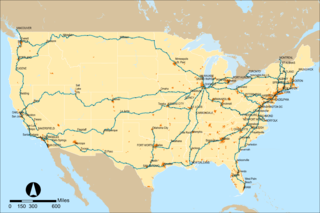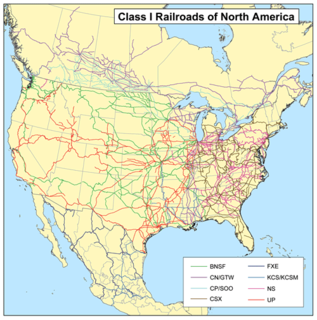
In rail transport, a train is a series of connected vehicles that run along a railway track and transport people or freight. Trains are typically pulled or pushed by locomotives, though some are self-propelled, such as multiple units. Passengers and cargo are carried in railroad cars, also known as wagons. Trains are designed to a certain gauge, or distance between rails. Most trains operate on steel tracks with steel wheels, the low friction of which makes them more efficient than other forms of transport.

The Underground Railroad was a network of clandestine routes and safe houses established in the United States during the early- to mid-19th century. It was used by enslaved African Americans primarily to escape into free states and Canada. The network was assisted by abolitionists and others sympathetic to the cause of the escapees. The enslaved who risked escape and those who aided them are also collectively referred to as the "Underground Railroad". Various other routes led to Mexico, where slavery had been abolished, and to islands in the Caribbean that were not part of the slave trade. An earlier escape route running south toward Florida, then a Spanish possession, existed from the late 17th century until approximately 1790. However, the network now generally known as the Underground Railroad began in the late 18th century. It ran north and grew steadily until the Emancipation Proclamation was signed by President Abraham Lincoln. One estimate suggests that by 1850, approximately 100,000 enslaved people had escaped to freedom via the network.

North America's first transcontinental railroad was a 1,911-mile (3,075 km) continuous railroad line constructed between 1863 and 1869 that connected the existing eastern U.S. rail network at Council Bluffs, Iowa with the Pacific coast at the Oakland Long Wharf on San Francisco Bay. The rail line was built by three private companies over public lands provided by extensive US land grants. Building was financed by both state and US government subsidy bonds as well as by company issued mortgage bonds. The Western Pacific Railroad Company built 132 miles (212 km) of track from the road's western terminus at Alameda/Oakland to Sacramento, California. The Central Pacific Railroad Company of California (CPRR) constructed 690 miles (1,110 km) east from Sacramento to Promontory Summit, Utah Territory. The Union Pacific Railroad (UPRR) built 1,085 miles (1,746 km) from the road's eastern terminus at the Missouri River settlements of Council Bluffs and Omaha, Nebraska westward to Promontory Summit.

The National Railroad Passenger Corporation, doing business as Amtrak, is the national passenger railroad company of the United States. It operates inter-city rail service in 46 of the 48 contiguous U.S. States and nine cities in Canada. Amtrak is a portmanteau of the words America and trak, the latter itself a sensational spelling of track.

The Union Pacific Railroad, legally Union Pacific Railroad Company and often called simply Union Pacific, is a freight-hauling railroad that operates 8,300 locomotives over 32,200 miles (51,800 km) routes in 23 U.S. states west of Chicago and New Orleans. Union Pacific is the second largest railroad in the United States after BNSF, with which it shares a duopoly on transcontinental freight rail lines in the Western, Midwestern and Southern United States.

The Baltimore and Ohio Railroad was the first common carrier railroad and the oldest railroad in the United States, with its first section opening in 1830. Merchants from Baltimore, which had benefited to some extent from the construction of the National Road early in the century, wanted to do business with settlers crossing the Appalachian Mountains. The railroad faced competition from several existing and proposed enterprises, including the Albany-Schenectady Turnpike, built in 1797, the Erie Canal, which opened in 1825, and the Chesapeake and Ohio Canal. At first, the B&O was located entirely in the state of Maryland; its original line extending from the port of Baltimore west to Sandy Hook, Maryland, opened in 1834. There it connected with Harper's Ferry, first by boat, then by the Wager Bridge, across the Potomac River into Virginia, and also with the navigable Shenandoah River.

The Penn Central Transportation Company, commonly abbreviated to Penn Central, was an American class I railroad that operated from 1968 to 1976. Penn Central was a combination of three railroads: the Pennsylvania Railroad (PRR), New York Central System (NYC) and the New York, New Haven and Hartford Railroad (NH). The NH was merged into Penn Central on January 1, 1969.

BNSF Railway is one of the largest freight railroads in North America. One of seven North American Class I railroads, BNSF has 35,000 employees, 32,500 miles (52,300 km) of track in 28 states, and nearly 8,000 locomotives. It has three transcontinental routes that provide rail connections between the western and eastern United States. BNSF trains traveled over 169 million miles in 2010, more than any other North American railroad.

CSX Transportation, known colloquially as simply CSX, is a Class I freight railroad operating in the Eastern United States and the Canadian provinces of Ontario and Quebec. The railroad operates approximately 21,000 route miles (34,000 km) of track. The company operates as the leading subsidiary of CSX Corporation, a Fortune 500 company headquartered in Jacksonville, Florida.
The Pennsylvania Railroad was an American Class I railroad that was established in 1846 and was headquartered in Philadelphia. Named for the commonwealth it was established in, by 1882, the Pennsylvania Railroad had become the largest railroad, the largest transportation enterprise, and the largest corporation in the world. Its budget was second only to the U.S. government.

The New York Central Railroad was a railroad primarily operating in the Great Lakes and Mid-Atlantic regions of the United States. The railroad primarily connected greater New York and Boston in the east with Chicago and St. Louis in the Midwest, along with the intermediate cities of Albany, Buffalo, Cleveland, Cincinnati, Detroit, Rochester and Syracuse. New York Central was headquartered in New York City's New York Central Building, adjacent to its largest station, Grand Central Terminal.

In the United States, railroad carriers are designated as Class I, II, or III, according to annual revenue criteria originally set by the Surface Transportation Board in 1992. With annual adjustments for inflation, the 2019 thresholds were US$504,803,294 for Class I carriers and US$40,384,263 for Class II carriers.

The New York, New Haven and Hartford Railroad, commonly known as The Consolidated, or simply as the New Haven, was a railroad that operated in the New England region of the United States from 1872 to December 31, 1968. Founded by the merger of the New York and New Haven and Hartford and New Haven railroads, the company had near-total dominance of railroad traffic in Southern New England for the first half of the 20th century.

The Southern Pacific was an American Class I railroad network that existed from 1865 to 1996 and operated largely in the Western United States. The system was operated by various companies under the names Southern Pacific Railroad, Southern Pacific Company and Southern Pacific Transportation Company.

The Atchison, Topeka and Santa Fe Railway, often referred to as the Santa Fe or AT&SF, was one of the larger railroads in the United States. The railroad was chartered in February 1859 to serve the cities of Atchison and Topeka, Kansas, and Santa Fe, New Mexico. The railroad reached the Kansas–Colorado border in 1873 and Pueblo, Colorado, in 1876. To create a demand for its services, the railroad set up real estate offices and sold farmland from the land grants that it was awarded by Congress.
The Erie Railroad was a railroad that operated in the northeastern United States, originally connecting New York City — more specifically Jersey City, New Jersey, where Erie's Pavonia Terminal, long demolished, used to stand — with Lake Erie, at Dunkirk, New York. It expanded west to Chicago with its 1865 merger with the former Atlantic and Great Western Railroad, also known as the New York, Pennsylvania and Ohio Railroad. Its mainline route proved influential in the development and economic growth of the Southern Tier of New York State, including cities such as Binghamton, Elmira, and Hornell. The Erie Railroad repair shops were located in Hornell and was Hornell's largest employer. Hornell was also where Erie's mainline split into two routes, one northwest to Buffalo and the other west to Chicago.

The Illinois Central Railroad, sometimes called the Main Line of Mid-America, was a railroad in the Central United States, with its primary routes connecting Chicago, Illinois, with New Orleans, Louisiana, and Mobile, Alabama. A line also connected Chicago with Sioux City, Iowa (1870). There was a significant branch to Omaha, Nebraska (1899), west of Fort Dodge, Iowa, and another branch reaching Sioux Falls, South Dakota (1877), starting from Cherokee, Iowa. The Sioux Falls branch has been abandoned in its entirety.

The Louisville and Nashville Railroad, commonly called the L&N, was a Class I railroad that operated freight and passenger services in the southeast United States.

Conrail, formally the Consolidated Rail Corporation, was the primary Class I railroad in the Northeastern United States between 1976 and 1999. The trade name Conrail is a portmanteau based on the company's legal name. It continues to do business as an asset management and network services provider in three Shared Assets Areas that were excluded from the division of its operations during its acquisition by CSX Corporation and the Norfolk Southern Railway.

Rail transportation in the United States consists primarily of freight shipments, with a well integrated network of standard gauge private freight railroads extending into Canada and Mexico. Passenger service is mainly mass transit and commuter rail in major cities. Intercity passenger service, once a large and vital part of the nation's passenger transportation network, plays a limited role as compared to transportation patterns in many other countries. The United States has the largest rail transport network size of any country in the world.


















